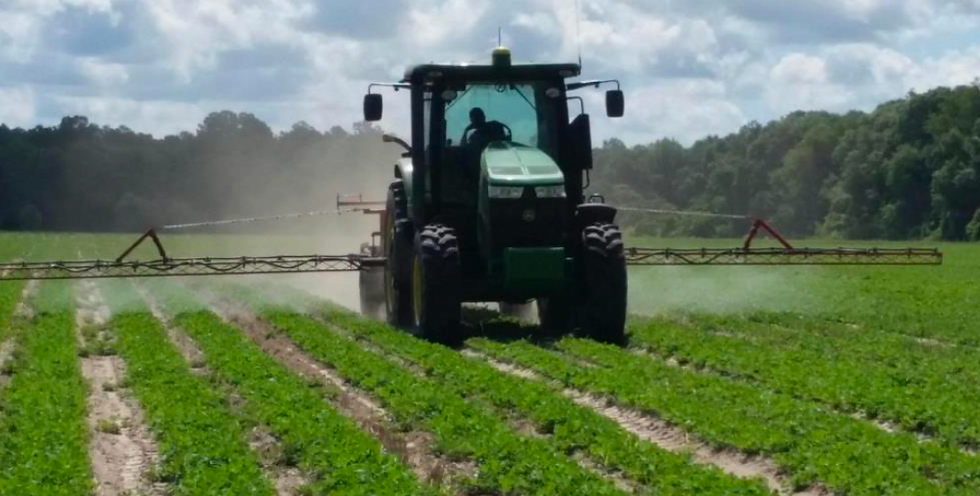Vigere Soil Report
Site: Putnal Farm, Mayo, Florida.
Date: April 2015
Objective: Enhance soil biology and crop yields by integrating commercial microbial inoculums into production practices in a sustainable and cost effective method on a commercial scale.
Crop Specifics: Putnal Farm located in North Florida produces primarily agronomic crops such as corn and peanuts. Soils in this region are generally sandy and well drained which typically require irrigation. For this test a seventy acre field was selected and planted into peanuts in April of 2015. A towable center pivot irrigation system which covered the entire seventy acre field was available for irrigation. The field was divided into two 35 acre tracts. Baseline microbial samples were taken at planting with fertilizer and all production practices being implemented the same on both tracts.

Action Plan: A plan was implemented to utilize a consortium of beneficial microbes including stable Purple Sulfur Bacteria (PSB) in conjunction with a 200 gallon microbe brewer to create an onsite biologically active inoculum for treatment of the southerly 35 acre tract. Microbial treatments utilized a tractor mounted spray boom which applied four applications over the growing season at a rate of 2 gallons of inoculum spray material per acre over the next 5 months of the crop cycle up to a week before harvest.

RESULTS AND OBSERVATIONS: During most of the crop growing season dry weather conditions prevailed. Due to chronic dry conditions the center pivot irrigation system was dedicated primarily to corn production so both the untreated and treated tracts did not receive optimum supplemental irrigation which negatively impacted the crop growth on both tracts. Later in the growing season excess rainfall was experienced on both tracts resulting in a harvesting delay of approximately 25 days. Both treated and untreated tracts experienced the same level of water stress as well as extended excess soil moisture conditions.

However, noticeable observations were made during this test trial. Even under water stress conditions the producer noticed that more tonnage of peanut vines was produced on the treated tract. Purple Sulphur Bacteria (PSB) has the ability to help the host crop plant regulate water availability. It was also noted that as the tractor moved over the peanut vines in the treated tract an odor similar to cucumbers was detected. Bacteria are known to emit particular odors as they colonize plant roots and foliage. A professional crop scout also reported that the peanut runners (rhizomes) in the treated tract were more strongly adhered to the plant than those in the untreated tract. This was a significant observation as the crop scout was unaware of the ongoing field test trials in this particular crop. During soil sampling just prior to harvest it was observed that all of the sample soil cores in the treated tract were friable with no soil sticking to the sampling cylinder. In contrast all the soil samples taken in the untreated tract were wet and compacted from previous heavy rainfall events. Soils with healthy soil microbial populations are known to be more friable due to the aggregation of soil particles caused by microbes which increases water infiltration in soils.

Final microbial testing indicated a positive microbial growth response in both the treated and untreated tracts. Baseline measurement for both tracts in colony forming units per kilogram (CFUs) at planting indicated 222,000 CFUs. The untreated tract averaged 1,088,000 CFUs at harvest and the treated tract averaged 3,456,000 CFUs, indicating a threefold increase in baseline values. Both tracts were harvested simultaneously with the same mechanical harvest practices. The plants in the treated tract exhibited a noticeable increase in root nodulation indicating that the leguminous peanut crop from the treated tract was able to fix more atmospheric nitrogen than the untreated tract. This increased nitrogen fixation may significantly and positively impact the crop to be planted in the treated tract in 2016.

Treated tract shows superior nitrogen nodulation.

Untreated tract nitrogen nodulation.
he most significant result from this test trial was obtained from the yield data received from the field buyer. Field trip tickets showed an average overall increase in yield of 472 pounds of peanuts per acre from the treated tract as compared to the untreated tract. This increase represented a yield increase of approximately of 16,500 pounds from the treated 35 acre tract. The market price at harvest was .18 cents a pound returning an additional $2,970.00 to the producer which more than offset the cost of the microbial inoculum applications on the treated tract.
Summary: Despite initial unfavorable growing conditions due to stress from a lack of water in addition to the excess rainfall experienced at harvest the application of microbial inoculums provided the best possible soil growing conditions producing a moderate increase in crop yields and monetary returns to the producer. An increase in top vine growth provided additional forage harvest potential while soil microbial populations remained in the treated field for use by subsequent crops. With consistent applications of microbial inoculums the soil profile can be enhanced in a sustainable manner consistent with standard farm production practices. With an increase in root nodulation commercial nitrogen fertilizer efficiencies can now be explored to offset the additional cost of the microbial applications. Greater fertilizer utilization can now be combined with a sustainable method of enhancing soil fertility while controlling costs even under adverse growing conditions. Commercial microbial inoculums are now of measurable benefit to farming operations and their surrounding environment.
